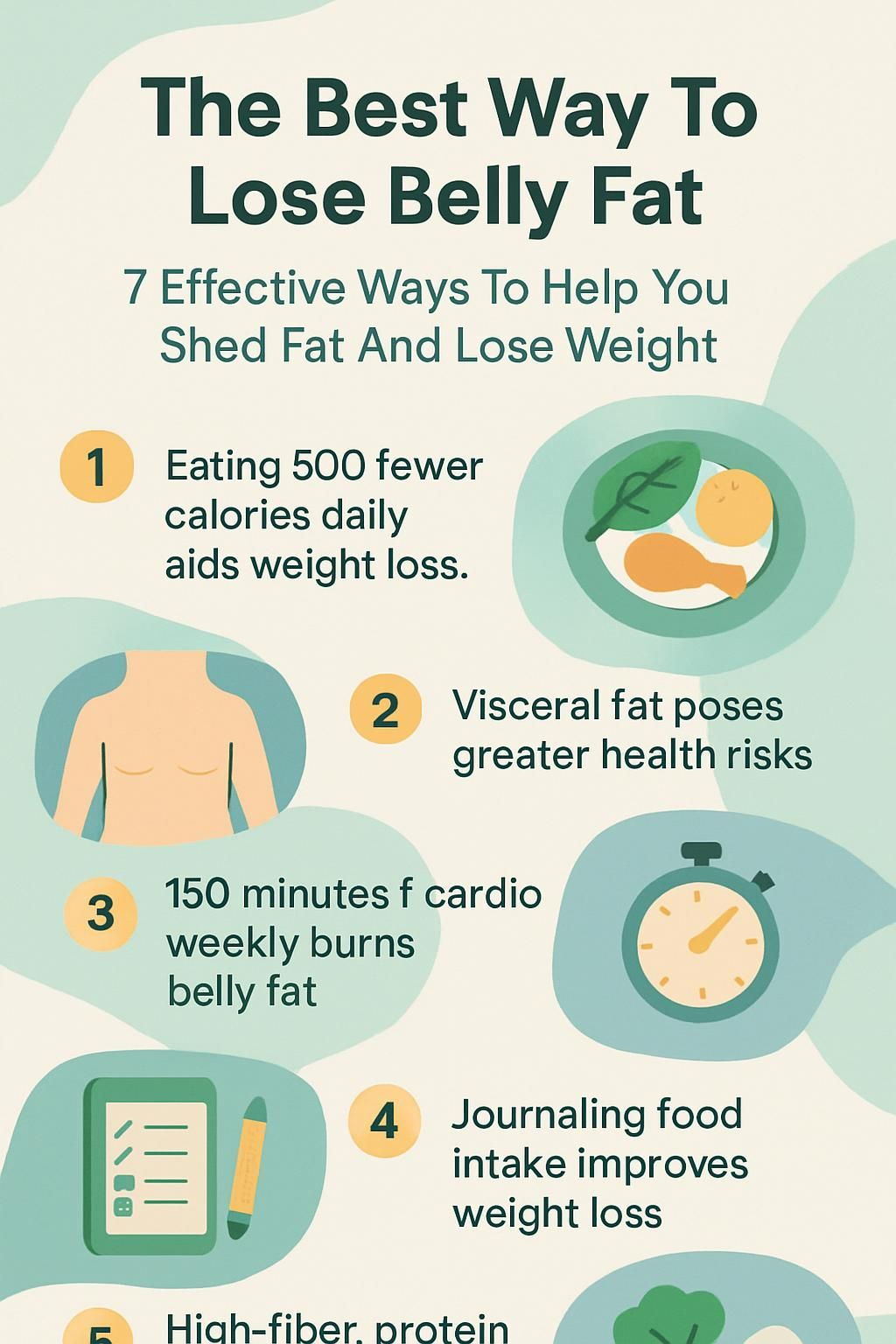The Best Way To Lose Belly Fat: 7 Effective Ways To Help You Shed Fat And Lose Weight
Our Nutrition Assistant AI Suite will transform your body. You will lose fat, get toned, and build muscle. Gain confidence and optimal health.
Trying to trim your waistline can feel frustrating, especially when belly fat will not budge. Extra fat around your middle raises the risk of heart disease, type 2 diabetes, and some cancers.
Here, you will learn seven effective ways to lose belly fat with a simple mix of smart eating, regular exercise, and daily habits that stick. Use these steps to help you lose weight and lower health risks for good.
Key Takeaways
- A balanced diet plus aerobic exercise, strength training, good sleep, and stress control helps reduce belly fat and supports heart health. Large centers like Mayo Clinic and a 2012 Johns Hopkins study back this approach.
- A daily calorie deficit of about 500 can lead to roughly one pound of weight loss per week. Protein and fiber help you stay full and keep weight off.
- Visceral fat, the deep fat around organs, is more risky than subcutaneous fat under the skin. It is linked to higher rates of heart disease, diabetes, cancer, and early death.
- Healthy adults should aim for at least 150 minutes of aerobic activity each week plus two strength sessions. This routine raises metabolism and helps burn abdominal fat.
- Tracking food and drinks with a journal or app improves results. Studies that followed people for years found consistent logging helps with weight loss.

What is Belly Fat? Types and Health Risks

Belly fat raises your risk for serious health problems, including type 2 diabetes and heart disease. Knowing the different types of abdominal fat helps you manage body composition and keep a healthy weight.
What are visceral and subcutaneous fat?
Visceral fat sits deep in your abdomen, wrapping around organs like the liver, pancreas, and kidneys. This intra-abdominal fat releases fatty acids and hormones into the blood that can lead to insulin resistance, cardiovascular disease, and metabolic syndrome.
Too much visceral fat is tied to a higher risk of chronic disease compared with other body fat. It is the most dangerous type to carry.
Subcutaneous fat lies under the skin. You can pinch it at the waist, thighs, or arms. It cushions the body and stores energy, but too much can still raise health risks.
Visceral belly fat increases health risks more than subcutaneous fat because it surrounds vital organs, according to Mayo Clinic guidance on abdominal obesity.
What health problems are linked to excess belly fat?
Excess belly fat is linked to heart disease, high blood pressure, and unhealthy blood fats. Johns Hopkins researchers reported in 2012 that losing belly fat improves artery flexibility and blood flow.
A waist over 35 inches for most women or over 40 inches for most men raises the risk for type 2 diabetes and fatty liver disease. Extra abdominal fat also increases blood sugar problems, sleep apnea, certain cancers like colon cancer, and early death.
People with higher amounts of visceral fat face more health problems than those with less fat around the waist.
Holistic Strategies for Belly Fat Reduction
A healthy diet, consistent physical activity, and steady habits work together to reduce belly fat. Focusing on all three brings the best and most lasting results.
How can diet, exercise, and lifestyle work together to reduce belly fat?
Pair a balanced diet with regular movement and simple lifestyle changes. Fill your plate with vegetables, lean proteins, beans, whole grains, nuts, and fiber-rich foods to control calories and reduce cravings.
Swap soda and other sweetened drinks for water. Walking with a friend most days can keep you motivated and supports smarter choices at meals.
Aerobic exercise like brisk walking or cycling burns calories. Aim for at least 150 minutes weekly to reduce total body fat. Strength training builds muscle mass, which raises your resting metabolism so you burn more even while sitting.
Prioritize sleep and manage stress to help lower cortisol, a stress hormone that can promote visceral fat storage. Support from family or a buddy makes these changes easier to maintain.
Physical activity works best for reducing belly fat when paired with mindful eating and quality sleep, according to the Mayo Clinic patient guide.
Nutrition sets the base for losing visceral fat. The next steps show how to make your eating plan work day to day.
How Should I Change My Diet to Lose Belly Fat?
Diet changes drive most fat loss, including belly fat. Use the strategies below to reduce calories while keeping meals satisfying.
How can I reduce my calorie intake effectively?
Start by tracking what you eat and drink with a journal or an app. Many people underestimate intake. To lose weight, you need a calorie deficit, which means eating fewer calories than you burn.
Most adults need around 2,000 to 2,500 calories a day. Eating about 500 fewer calories daily can help you lose around one pound per week. Smaller portions at meals lower total intake without feeling deprived.
Choose nutrient-dense foods like vegetables, fruit, yogurt, fish, eggs, beans, and whole grains. Drink water instead of sugary drinks. Try smaller plates at dinner and set a cut-off time for late-night snacking.
Why should I avoid processed foods and sugars?
Processed foods often contain added sugars, unhealthy fats, and lots of sodium. These calories add up fast and can push more fat storage around the waist.
Many low-fat products rely on extra sugar to taste good. Check labels for added sugars and high sodium. Diets rich in processed foods are linked to higher risks of heart disease and type 2 diabetes.
Choosing whole foods helps reduce visceral fat and supports better fitness results. It also makes calorie control easier.
How does increasing fiber help with belly fat loss?
Fiber, especially soluble fiber, slows digestion and helps you feel full longer. Research suggests adding about 10 grams of soluble fiber per day can reduce belly fat gain over time.
Good sources include beans, oats, barley, apples, berries, and vegetables. Even simple swaps, like whole grain bread instead of white, can curb hunger and reduce snacking.
What are the benefits of low-carb and Mediterranean diets?
Low-carb and Mediterranean diets often reduce belly fat faster than standard low-fat plans. In one Johns Hopkins trial, a low-carb plan led to greater weight loss in six months compared with a low-fat diet with the same calories.
Both patterns feature higher fiber and protein, which keep you full. They also limit sugary and ultra-processed foods, promote healthy fat from olive oil and nuts, and favor lean proteins and whole grains.
Pair either approach with regular aerobic activity and resistance training to speed progress and protect muscle mass.
What Exercises Help Reduce Belly Fat?
Exercise helps burn calories and supports fat loss across your whole body, including the abdomen. A steady routine makes a visible difference at your waistline.
How does aerobic exercise contribute to belly fat loss?
Aerobic exercise helps reduce belly fat by increasing calorie burn and improving insulin sensitivity. Activities like brisk walking, jogging, cycling, or swimming strengthen your heart and lungs while fueling your muscles.
Aim for at least 150 minutes of moderate activity or 75 minutes of vigorous activity each week. A 2015 study found that 300 minutes per week led to greater fat loss than half that time.
Regular movement can lower insulin levels, which reduces fat storage in the belly area. A daily walk after work is a simple way to meet the guidelines and see steady changes.
Why is strength training important for fat loss?
Strength training builds lean muscle. Muscle uses more energy at rest than fat, so your metabolism rises as you gain muscle mass.
Health authorities recommend at least two resistance training sessions per week. Combine lifting with aerobic exercise to burn calories now and keep fat off later. People who lift weights hold on to more muscle while losing weight.
Add two full-body sessions weekly with moves like squats, rows, presses, and hinges. This mix helps trim your waist and keeps energy steady.
What core exercises help tone the belly area?
Crunches, planks, and side planks strengthen the core, including the rectus abdominis and obliques. A stronger core improves posture and makes your midsection feel firmer.
Do core work 2 to 3 times per week. Keep in mind that visible belly changes come from lowering total body fat through diet and exercise, not from core moves alone.
How Can Lifestyle Changes Support Fat Loss?
Daily habits like sleep and stress management influence appetite, hormones, and how your body stores fat. Small changes compound over time.
Why is getting enough sleep important for weight loss?
Short sleep, under 5 hours per night, is linked to weight gain. A large 16-year study of more than 68,000 women found those who slept less gained more weight.
Sleep supports the endocrine system and keeps hunger and stress hormones in balance. Poor sleep can increase appetite, reduce muscle mass, and nudge the body to store more fat.
Set a regular bedtime, keep the room dark and cool, and limit screens before bed. Many people notice fewer cravings and a smaller waist with better sleep.
How does stress affect belly fat?
Chronic stress raises cortisol, a hormone that encourages fat storage around the waist. Women may be especially likely to gain visceral fat during ongoing stress.
This type of fat surrounds organs and is tied to high triglycerides, artery problems, and inflammation. You might see your waist grow even if calories stay the same.
Practice stress reducers like walking, yoga, or simple breathing drills. Ten minutes a day can help lower stress and support fat loss.
What healthy habits support sustainable fat loss?
Use a journal or app to track food and exercise. People who log consistently tend to lose more weight. Replace sugary drinks with water, seltzer, or tea.
Fill half your plate with fruits and vegetables, then add lean protein and whole grains. Limit snacking after dinner to prevent extra calories when your body is winding down.
These habits support organ health and help reduce risks linked to overweight and obesity.
Additional Tips to Help Lose Belly Fat
Small daily choices can speed progress. The ideas below are easy to start and sustain.
How does green tea boost metabolism?
Green tea contains EGCG, an antioxidant, and caffeine. Together they may slightly raise calorie burn at rest.
Some studies show that drinking green tea for several weeks supports modest weight loss. It is not a magic fix, but a cup or two can support your plan.
Why is staying hydrated important for fat loss?
Water aids digestion and helps nutrients move through the body. It also helps you feel full, so you may eat less at meals.
Research shows that drinking two cups of water before meals can increase weight loss over 12 weeks. Hydration supports metabolism, including how your cells use fat for energy.
Try a glass with every meal and keep a bottle nearby during the day.
How can controlling portion sizes reduce belly fat?
Portion control reduces total calories without banning favorite foods. Many people eat less when served smaller amounts.
Use smaller plates, measure staples like rice or pasta, and pre-portion snacks. Even cutting meal size by about 25 percent can lower daily calories by hundreds.
Why avoid snacking after dinner?
Evening snacking adds extra calories when activity is low. A 2017 study found late eaters consumed about 248 more calories per day.
Finish dinner at a set time and choose water or herbal tea later. Many people find this simple step shrinks cravings the next day.
Why Are Patience and Sustainability Important in Fat Loss?
Lasting change comes from steady habits, not quick fixes. Think progress, not perfection.
How do long-term lifestyle changes impact fat loss?
Small daily changes add up and help you keep weight off. A routine with balanced meals, aerobic exercise, strength training, enough sleep, and stress control works better than short-term plans.
Losing even five percent of body weight can reduce risks linked to visceral fat and heart disease. Replacing late-night snacks with tea, or taking a short walk after meals, can make a real difference.
What should I expect regarding gradual improvements?
You may notice your clothes fit better before big changes show on the scale. As you gain muscle and lose fat, the waistline often shrinks first because muscle is denser than fat.
Look for signs like more energy, better sleep, and easier movement within a few weeks. Tracking meals and reducing processed foods helps keep progress steady.
When Should I Seek Professional Help for Belly Fat Loss?
If your waist is not changing or you have health concerns, talk with a healthcare professional. Expert guidance can save time and improve safety.
How can healthcare providers tailor belly fat loss advice?
Weight management clinicians consider age, genetics, menopause status, and medical history. They may check cholesterol and blood sugar, then suggest a plan that targets visceral fat and protects muscle.
You might receive a meal plan higher in fiber and protein, plus a progression for aerobic exercise and resistance training. Many clinics also address sleep and stress habits.
If you struggle with disordered eating, contact the National Alliance for Eating Disorders or SAMHSA at 1-800-662-4357, TTY 1-800-487-4889.
This article is for education only. For personal advice, consult your doctor, especially if you have a medical condition or take medications.
What Are Common Myths About Belly Fat?
White-noise advice can slow your progress. Focus on what evidence supports, and skip the myths.
Is spot reduction a real way to lose belly fat?
No. Working a single body part, like doing lots of crunches, will not remove fat only from that spot. The body pulls stored energy from many areas at once during exercise.
Visceral fat responds best to a mix of calorie control and aerobic activity. A whole-body plan beats spot training every time.
What is the truth about fat-burning foods?
There is no food that targets fat only at your waistline. What matters most is total calorie balance and diet quality. Fiber-rich foods and protein help you feel full on fewer calories, which supports fat loss across the body.
Green tea may offer a small boost, but it will not shrink the belly on its own. Focus on consistent habits and portion control.
Summary Table: Fat-Burning Food Myths vs Facts
| Myth | Fact |
|---|---|
| Some foods target belly only | No food targets a single area |
| Green tea melts a lot of fat | Only a minor metabolic boost |
| Certain fruits shrink abdominal cells | Healthy choices support calorie control, not spot loss |
What Are the Benefits of Losing Belly Fat?
Trimming belly fat delivers clear wins. You may feel lighter, move easier, and see a healthier waistline.
How does losing belly fat improve heart health?
Less abdominal fat helps arteries stay flexible and improves blood flow. In a Johns Hopkins study, both low-fat and low-carb diets improved artery function as people lost weight.
More flexible arteries reduce strain on your heart during daily tasks. Climbing stairs, walking fast, or finishing a workout can start to feel easier.
How does it reduce risks of chronic diseases?
Lower visceral fat reduces inflammation and supports better blood sugar control. That means lower risk for type 2 diabetes, fatty liver disease, stroke, and some cancers.
Balanced eating, aerobic exercise, and strength work together to protect long-term organ health.
How does fat loss increase energy and mobility?
Losing belly fat lightens the load on joints and muscles. Even a 5 to 10 percent drop in body weight can improve blood vessel function and oxygen delivery.
With better sleep and steady activity, your energy rises and daily movement feels smoother. Many people notice fewer aches and faster recovery.
Conclusion
Keeping your waistline in a healthy range protects vital organs and lowers disease risk. Pair a balanced diet with aerobic exercise and strength training to help you lose belly fat and keep it off.
Prioritize fiber, watch calories, manage stress, sleep well, and track what you eat. Small, steady steps compound into lasting results. If you have medical concerns, seek guidance from your healthcare provider before changing your routine.
FAQs
1. How does belly fat affect organs in the body?
Belly fat can build up around internal organs, such as the liver and pancreas. This buildup may increase health risks like heart disease and diabetes, according to studies from the National Institutes of Health.
2. Are crunches effective for reducing waistline size?
Crunch exercises help strengthen abdominal muscles but do not target fat loss in a specific area. Research shows that overall weight loss through diet and exercise is more effective for shrinking your waistline than spot training alone.
3. What role do cells play in losing belly fat?
Fat cells store energy from food as triglycerides. When you burn more calories than you eat, these cells release stored energy so your body can use it as fuel; this process helps reduce total body fat including around the abdomen.
4. Can clothing choices impact how my waistline looks during weight loss?
Wearing fitted or high-waisted clothing can highlight changes in your waistline while losing weight; however, clothes cannot change cell biology or organ function related to belly fat reduction.
Summary: Belly fat affects vital organs and involves biological processes at the cellular level. Crunches support muscle strength but are not enough on their own for significant waistline reduction; whole-body strategies work best according to evidence-based research. Clothing may enhance appearance but does not influence actual biological changes within organs or cells.







